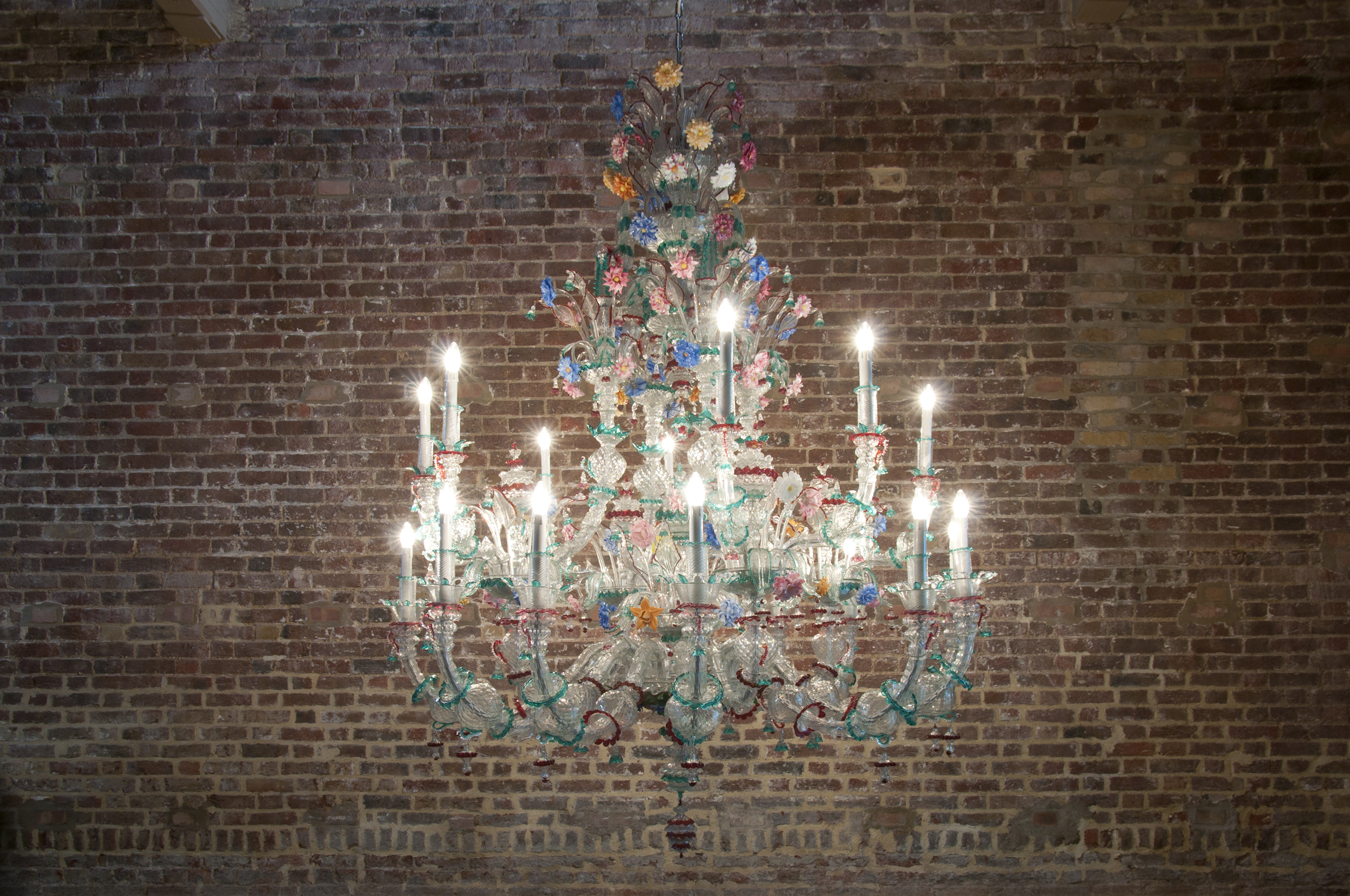In a brick-arched space of the Serpentine Sackler Gallery—a Grade 1-listed 19th-century building in the middle of Hyde Park, originally designed to store gunpowder during the Napoleonic wars—a strange noise is being emitted. It comes from a pair of transparent cast-acrylic flutes that hang suspended from the ceiling, calling and responding one to another. The sounds from Interlude (A=D-R=I=F=T) (2014) suggest wind and dripping water, with the odd clack of what might be bamboo knocking against bamboo. The effect is Zen-like and rather ethereal. It infiltrates the whole gallery space, drawing together disparate elements—rather as a melody might draw together the different sections of an orchestra. While the ear is seduced by this strangely hypnotic music, the eye is drawn by a long strip of arcane poetic/philosophical text in neon tubing that runs round the upper walls of the gallery like a glittery postmodern version of a classical frieze. Spare and cold, it has a stylish elegance. Some of the works on show have been created especially for this site-specific installation by the Welsh artist Cerith Wyn Evans; others have been shown before at White Cube in London and Bergen Kunsthall, Norway.
Among the latter is S=U=P=E=R=S=T=R=U=C=T=U=R=E (Trace me back to some loud, shallow, chill, underlying motive’s overspill …) (2010) the first work encountered on entering the gallery. Its references are classical and architectural. The pillar-shaped “drums” are made from light bulb filaments bound together to suggest Doric columns that emit both light and heat. Beside this is H=0=S=T ‘Backstage at Bunraku by Barbara C. Adachini’ (1985) (2014)—which, apparently, is a text on a behind-the-scenes look at Japan’s traditional puppet theater. (Why the endless equal signs in the titles? Not sure what they’re supposed to add, other than a spurious gravitas.) Here sputnik-style chandeliers direct a Morse code program that stutters and stops on a nearby computer screen. Wyn Evans claims his inspiration came one night while looking down from a hotel window at the lights of Tokyo, which he says “was like an enormous matrix of signs and circuits that was somehow alive, a body in a sense … communicating with itself.” Among his accumulated newspaper clippings was one announcing that the military would no longer use Morse code. In effect, it would become a decommissioned language, an obsolete linguistic ghost. The implication seems to be that communication is complex and difficult. Otherworldly contact and parallel narratives are suggested, meanings are not fixed but slippery and elusive.
Elsewhere there’s an installation of amethyst geodes set among a bunch of somewhat sickly looking plants, and a number of chandeliers that dim and then flare, as if inhaling and exhaling breath. One is made of exotic Venetian glass and has an equally exotic title: We are in Yucatan and every unpredicted thing (2014), another, Taraxacum (2014) is constructed like a bubble from large light bulbs. Across the space images flicker on silk screens. One appears to come from an old photograph of a Victorian prostitute sitting naked on her client’s lap as he paws her, money strewn around their feet. Make of that what you will.
In the 1980s Wyn Evans was a filmmaker, part of the countercultural generation that included filmmaker, Derek Jarman for whom he worked as an assistant, before moving on to make his own short experimental films. By the 1990s, he had recast himself as a shimmering Young British Artist. His work is characterized by a focus on language and a conceptual approach that grows out of his relationship to the exhibition space. In his own words, “the site of the gallery, the perception of sight, the citation of references are multiple and swarming.” His references range from John Cage, Rainer Werner Fassbinder, Gilles Deleuze, Marcel Proust and Andy Warhol.
A collection of previously unpublished black-and-white photographs—atmospheric, minimal and rather beautiful, full of light and shadows—has been produced to accompany the exhibition. This elegant catalog is introduced with a rather obtuse text entitled “Neveralreadyseen” by the French feminist philosopher Hélène Cixous. Oh those French, how they do love to obfuscate!
Poetry is increasingly important to Wyn Evans; not Romantic lyrical poetry but that of experimental poets who break down language—David Antin, John Cage, e. e. cummings and James Merrill, who takes words from an Ouija board. It’s been suggested that Wyn Evans installations function as catalysts: reservoirs of possible meaning that unravel in a number of interpretations on different discursive journeys. Elegant and evocative, they nevertheless sometimes seem to try too hard. Still, the haunting flute music did stay with me as I walked out of the gallery into the mellow autumn afternoon in Hyde Park.



















0 Comments